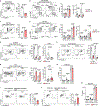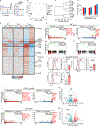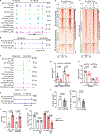Bcl11b sustains multipotency and restricts effector programs of intestinal-resident memory CD8+ T cells
- PMID: 37115913
- PMCID: PMC10231135
- DOI: 10.1126/sciimmunol.abn0484
Bcl11b sustains multipotency and restricts effector programs of intestinal-resident memory CD8+ T cells
Abstract
The networks of transcription factors (TFs) that control intestinal-resident memory CD8+ T (TRM) cells, including multipotency and effector programs, are poorly understood. In this work, we investigated the role of the TF Bcl11b in TRM cells during infection with Listeria monocytogenes using mice with post-activation, conditional deletion of Bcl11b in CD8+ T cells. Conditional deletion of Bcl11b resulted in increased numbers of intestinal TRM cells and their precursors as well as decreased splenic effector and circulating memory cells and precursors. Loss of circulating memory cells was in part due to increased intestinal homing of Bcl11b-/- circulating precursors, with no major alterations in their programs. Bcl11b-/- TRM cells had altered transcriptional programs, with diminished expression of multipotent/multifunctional (MP/MF) program genes, including Tcf7, and up-regulation of the effector program genes, including Prdm1. Bcl11b also limits the expression of Ahr, another TF with a role in intestinal CD8+ TRM cell differentiation. Deregulation of TRM programs translated into a poor recall response despite TRM cell accumulation in the intestine. Reduced expression of MP/MF program genes in Bcl11b-/- TRM cells was linked to decreased chromatin accessibility and a reduction in activating histone marks at these loci. In contrast, the effector program genes displayed increased activating epigenetic status. These findings demonstrate that Bcl11b is a frontrunner in the tissue residency program of intestinal memory cells upstream of Tcf1 and Blimp1, promoting multipotency and restricting the effector program.
Conflict of interest statement
COMPETING INTERESTS
The authors declare no competing interests.
Figures








References
-
- Masopust D, Vezys V, Marzo AL, Lefrancois L, Preferential localization of effector memory cells in nonlymphoid tissue. Science 291, 2413–2417 (2001). - PubMed
-
- Wherry EJ, Teichgraber V, Becker TC, Masopust D, Kaech SM, Antia R, von Andrian UH, Ahmed R, Lineage relationship and protective immunity of memory CD8 T cell subsets. Nat Immunol 4, 225–234 (2003). - PubMed
-
- Sallusto F, Lenig D, Forster R, Lipp M, Lanzavecchia A, Two subsets of memory T lymphocytes with distinct homing potentials and effector functions. Nature 401, 708–712 (1999). - PubMed
Publication types
MeSH terms
Substances
Grants and funding
LinkOut - more resources
Full Text Sources
Molecular Biology Databases
Research Materials
Miscellaneous

